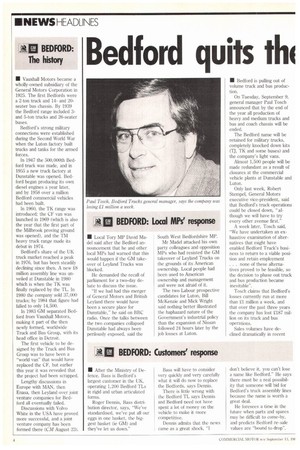BEDFORD: The history
Page 6

If you've noticed an error in this article please click here to report it so we can fix it.
• Vauxhall Motors became a wholly-owned subsidiary of the General Motors Corporation in 1925. The first Bedfords were a 2-ton truck and 14and 20seater bus chassis. By 1939 the Bedford range included 3and 5-ton trucks and 26-seater buses.
Bedford's strong military connections were established during the Second World War when the Luton factory built trucks and tanks for the armed forces.
In 1947 the 500,000th Bedford truck was made, and in 1955 a new truck factory at Dunstable was opened. Bedford began producing its own diesel engines a year later, and by 1958 over a million Bedford commercial vehicles had been built.
In 1960, the TK range was introduced; the CF van was launched in 1969 (which is also the year that the first part of the Millbrook proving ground was opened), and the TM heavy truck range made its debut in 1974.
Bedford's share of the UK truck market reached a peak in 1976, but has been steadily declining since then. A new £8 million assembly line was unveiled at Dunstable in 1980 which is when the TK was finally replaced by the IL. In 1980 the company sold 37,000 trucks; by 1984 that figure had failed to only 14,500.
In 1983 GM separated Bedford from Vauxhall Motors, making it part of the then newly formed, worldwide Truck and Bus Group, with its head office in Detroit.
The first vehicle to be designed by the Truck and Bus Group was to have been a "world van" that would have replaced the CF, but earlier this year it was revealed that the project had been scrapped.
Lengthy discussions in Europe with MAN, then Enasa, then Leyland over joint venture companies for Bedford all eventually failed.
Discussions with Volvo White in the USA have proved more successful, and a joint venture company has been formed there (CM August 23).




























































































